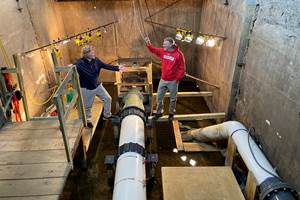Zortrax Offers Metal Systems for Producing Complex End-Use Parts
In addition, the company also offers Victrex AM 200 filament, which has a lower melting point than PEEK and can be extruded in lower temperatures.
Share
Read Next
Zortrax’s Endureal industrial 3D printer comes in two comprehensive sets for metal 3D printing — the Full Metal Package 17-4 PH and Full Metal Package 316L. It is said each Zortrax Full Metal Package contains all the essentials for an easy start with metal 3D printing and includes either BASF Ultrafuse 316L or BASF Ultrafuse 17-4 PH, which are metal-polymer filaments from BASF Forward AM.
In addition, the company also offers Victrex AM 200 filament, which has a lower melting point than PEEK and can be extruded in lower temperatures. This low-melt PAEK filament is a high-performance polymer from the same thermoplastics family as Z-PEEK, which offers similar, or in some areas, even better 3D printing results, the company says.
Zortrax Full Metal Package 316L includes BASF Ultrafuse 316L, a filament composed of 80% 316L stainless steel and 20% polymer. The 316L is a surgical-grade stainless steel, containing over 10% of chromium. This chemical element, while in contact with oxygen, causes a thin coating layer to form on the surface of the model, protecting it from corrosion. The company says the parts 3D printed with this material have up to 561 MPa tensile strength, 251 MPa yield strength, up to 53% elongation at break and have a nonmagnetic microstructure. All these features make this metal-polymer filament well suited for 3D printing complex end-use parts, automotive parts, medical equipment, chemical pipes or valves, elements of tools and fixtures as well as various functional prototypes.
Zortrax Full Metal Package 17-4 PH contains BASF Ultrafuse 17-4 PH, an industrial composite filament, comprising 80% of 17-4 hardened steel and 20% of polymer content. Models 3D printed with this filament are characterized by up to 1004 MPa tensile strength, 764 MPa yield strength, up to 4% elongation at break and have a magnetic microstructure. This material can be used for parts that require significant hardness, including chemical pipes or valves, strong metal end-use parts, medical equipment, automotive parts, elements of tools and fixtures, and functional prototypes.
Both packages include the BASF Ultrafuse support layer, which is a dedicated support material for ensuring the desired geometry of the printed parts during the 3D printing and postprocessing stages; Magigoo Pro Metal adhesive to provide reliable adhesion during printing and the easy removal of the printed part; an extra hotend module with brass nozzles for Zortrax Endureal; and a voucher for professional postprocessing in Elnik company (BASF’s partner in Germany), where 3D prints undergo crucial sintering and debinding processes to achieve all the properties of steel.
Another product introduced for Zortrax Endureal is Victrex AM 200 low-melt PAEK filament, a high-performance polymer that belongs to the same thermoplastics’ family as Z-PEEK. The most important features of the materials include low viscosity, assuring easier flow through the nozzle, slow crystallization rate facilitating strong interlayer bonding that improves tensile strength along the Z-axis, high dimensional stability, and minimized warpage.
The material is well suited for manufactured parts that require chemical resistance, significant mechanical strength and need to withstand extreme temperatures. The polymer combines all the advantages of PEEK and adds other benefits such as higher strength values, especially in the Z-axis, less shrink and warpage and soluble support compatibility. Moreover, it features a wider process window which can improve production outcomes and offer further design freedom.
- Read how Zortrax’s trio is a complete resin 3D printing and postprocessing system, including the Zortrax Inkspire 2 UV-LCD 3D printer, Zortrax Cleaning Station and Zortrax Curing Station.
- Learn how ML Systems saved up to two weeks of lead time and up to 90% of prototype fabrication costs by using Zortrax’s M300 Plus 3D printer to print prototypes in-house.
Related Content
What is Powder Bed Fusion 3D Printing?
Whether in metal or polymer, with a laser or an electron beam, powder bed fusion (PBF) is one of the most widely used 3D printing techniques.
Read MoreHow Large-Format 3D Printing Supports Micro-Scale Hydropower
There is potential hydroelectric power that has never been unlocked because of the difficulty in capturing it. At Cadens, additive manufacturing is the key to customizing micro-scale water turbine systems to generate electricity from smaller dams and waterways.
Read MoreLarge-Format “Cold” 3D Printing With Polypropylene and Polyethylene
Israeli startup Largix has developed a production solution that can 3D print PP and PE without melting them. Its first test? Custom tanks for chemical storage.
Read MoreHow to Build 10,000+ Shot Molds in Hours
Rapid tooling isn’t so rapid when it takes days to 3D print a metal mold, and then you still must machine it to reach the necessary tolerances. With Nexa3D’s polymer process you can print a mold in hours that is prototype or production ready and can last for more than 10,000 shots.
Read MoreRead Next
At General Atomics, Do Unmanned Aerial Systems Reveal the Future of Aircraft Manufacturing?
The maker of the Predator and SkyGuardian remote aircraft can implement additive manufacturing more rapidly and widely than the makers of other types of planes. The role of 3D printing in current and future UAS components hints at how far AM can go to save cost and time in aircraft production and design.
Read More3D Printing Brings Sustainability, Accessibility to Glass Manufacturing
Australian startup Maple Glass Printing has developed a process for extruding glass into artwork, lab implements and architectural elements. Along the way, the company has also found more efficient ways of recycling this material.
Read More4 Ways the Education and Training Challenge Is Different for Additive Manufacturing
The advance of additive manufacturing means we need more professionals educated in AM technology.
Read More





.png;maxWidth=300;quality=90)















